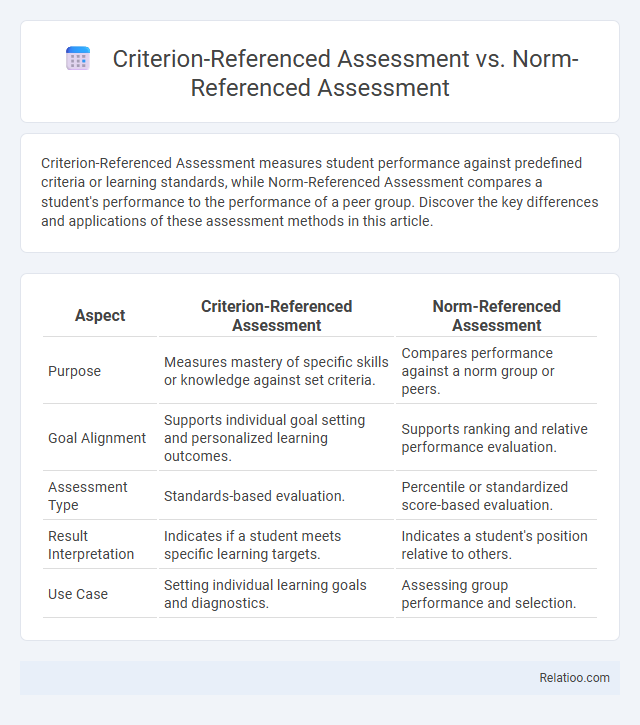Criterion-Referenced Assessment measures student performance against predefined criteria or learning standards, while Norm-Referenced Assessment compares a student's performance to the performance of a peer group. Discover the key differences and applications of these assessment methods in this article.
Table of Comparison
| Aspect | Criterion-Referenced Assessment | Norm-Referenced Assessment |
|---|---|---|
| Purpose | Measures mastery of specific skills or knowledge against set criteria. | Compares performance against a norm group or peers. |
| Goal Alignment | Supports individual goal setting and personalized learning outcomes. | Supports ranking and relative performance evaluation. |
| Assessment Type | Standards-based evaluation. | Percentile or standardized score-based evaluation. |
| Result Interpretation | Indicates if a student meets specific learning targets. | Indicates a student's position relative to others. |
| Use Case | Setting individual learning goals and diagnostics. | Assessing group performance and selection. |
Introduction to Assessment Types
Criterion-referenced assessment measures a student's performance against a defined set of learning standards or criteria, determining whether specific skills or knowledge have been acquired. Norm-referenced assessment compares a student's performance to that of a peer group, ranking individuals on a percentile scale to identify relative standing. These assessment types serve distinct purposes in educational evaluation, with criterion-referenced tests emphasizing mastery of content and norm-referenced tests highlighting comparative achievement.
Defining Criterion-Referenced Assessment
Criterion-Referenced Assessment measures a student's performance against a predefined set of learning standards or criteria, emphasizing mastery of specific skills or knowledge. Unlike Norm-Referenced Assessment, which compares a student's performance to that of peers, Criterion-Referenced Assessment provides detailed insights into individual competency levels. This targeted evaluation method supports personalized learning and helps educators identify areas needing improvement.
Understanding Norm-Referenced Assessment
Norm-referenced assessment compares Your performance against a defined group, ranking individuals to determine relative standing rather than mastery of content. It uses standardized testing to evaluate where You fall on a percentile scale, helping identify strengths and weaknesses compared to peers. Understanding norm-referenced assessment is critical for interpreting results in educational contexts, distinguishing it from criterion-referenced assessments which measure proficiency against fixed benchmarks.
Key Differences Between Criterion and Norm-Referenced Assessments
Criterion-referenced assessments measure your performance against specific learning standards or criteria, determining whether you have mastered particular skills or knowledge. Norm-referenced assessments compare your performance to that of a peer group, ranking individuals to identify relative standing rather than mastery. The key difference lies in the evaluation focus: criterion-referenced assessments assess achievement against fixed objectives, whereas norm-referenced assessments prioritize comparative ranking.
Advantages of Criterion-Referenced Assessment
Criterion-referenced assessment offers precise measurement of a learner's performance based on predefined standards, enabling clear identification of specific skills and knowledge mastery. This assessment type promotes targeted instruction and personalized feedback, facilitating improved learning outcomes and skill development. Compared to norm-referenced assessment, it avoids competition among learners by focusing on individual achievement relative to set criteria.
Benefits of Norm-Referenced Assessment
Norm-referenced assessment offers the benefit of clearly ranking students by comparing individual performance against a large, representative peer group, which helps identify strengths and weaknesses relative to others. This method provides valuable data for schools and employers to make decisions based on percentile ranks or standardized scores, enabling targeted interventions or selection processes. Your understanding of student achievement and progress will be more actionable when using norm-referenced assessments to benchmark against national or regional standards.
Drawbacks and Limitations of Each Approach
Criterion-referenced assessments often face challenges related to setting appropriate performance standards, which can lead to inconsistent interpretations of mastery. Norm-referenced assessments may unfairly disadvantage individuals who perform well but fall below the average due to their dependency on comparative outcomes rather than absolute skills. Your choice of assessment should consider how these drawbacks impact fairness, validity, and the ability to provide meaningful feedback.
Suitable Contexts for Each Assessment Type
Criterion-referenced assessment is suitable for measuring your mastery of specific skills or knowledge against predefined standards, making it ideal for educational settings focused on competency and skill development. Norm-referenced assessment compares an individual's performance to that of a peer group, commonly used in admissions or placement contexts to rank or categorize students. General assessment varies widely, but selecting the right type depends on whether the goal is to evaluate absolute performance, relative standing, or formative feedback within your specific context.
Impact on Student Learning and Outcomes
Criterion-referenced assessment measures your performance against predefined learning goals, providing clear feedback on areas of mastery and improvement, which directly supports targeted student growth. Norm-referenced assessment compares student outcomes to peers, offering insights into relative standing but often lacking detailed information for personalized learning strategies. Understanding the distinct impacts of these assessments helps educators tailor instruction to enhance student achievement and foster meaningful progress.
Choosing the Right Assessment Method
Choosing the right assessment method depends on the purpose: criterion-referenced assessments measure student performance against specific learning standards, ideal for mastery learning and targeted instruction. Norm-referenced assessments compare a student's performance to a peer group, useful for ranking and identifying relative abilities within a population. Understanding the goals of evaluation--whether to determine individual proficiency or relative standing--guides educators in selecting between criterion-referenced and norm-referenced assessments for accurate and meaningful results.

Infographic: Criterion-Referenced Assessment vs Norm-Referenced Assessment
 relatioo.com
relatioo.com